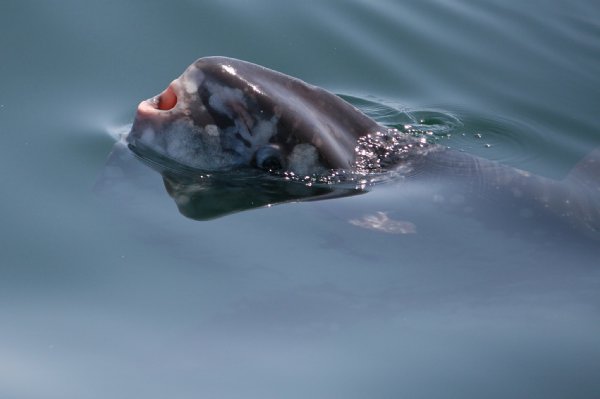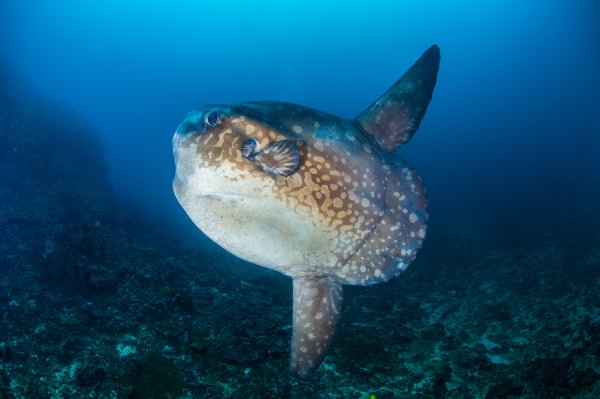This Bizarre Fish Might Be Your New Favorite Animal
Published by Ocean Conservancy
You may have seen them in the news before. Whether happened upon by scuba divers or spotted by fishermen, one big question always pops up about this fish: what is it? One of the most strikingly unique looking fish in the ocean, Mola mola (or sunfish) seem to spark an incomparable curiosity in people. I’m here to answer your biggest questions about this fascinating, not-so-little fish.
So…what are they exactly?
It’s definitely challenging to identify what they are at first glance, but sunfish are, in fact, fish—they’re a member of the bony fish class, known as Osteichthyes. This classification of fishes also includes species like marlins and swordfishes but does not include cartilaginous cousins of the mola, like sharks and rays. The primary differentiating factor for Osteichthyes is a skeleton at least partially made up of bone, rather than just cartilage alone. Fun fact: though related by a further degree of classification, sunfish are actually distant relatives to pufferfish! Their shared lineage is most evident in their youth, as baby mola are born round and puffy, with spines covering their bodies (much like pufferfish have). While mola obviously grow to look much different from these cousins in adulthood, the physical similarity witnessed here is likely why some scientists have called them “pufferfish on steroids.”
Learn more about your favorite fish
What’s the deal with its shape…and what about the fin situation?
Interestingly, “mola” actually means “millstone” in Latin, which describes the animal’s somewhat circular, flat shape and rough skin. While they’re born looking a bit like pufferfish, the reason that they look the way they do has to do with the relative growth of their back fin—or, more accurately, lack thereof. This back fin doesn’t grow as it does for other fish. Instead, it folds inward to create a curiously scalloped muscle segment that forms into a rudder-like shape, known as a clavus.
With bodies like that, how are they able to swim?
Simple: they use the fins they do have for propulsion (the anal and dorsal fins) to move a bit awkwardly but very purposefully through the water. And their clavus isn’t just there for no reason: it really does work like a rudder, allowing them to steer their bulky bodies as they swim.
Why are they called “sunfish?”
Believe it or not, this has more to do with the animal’s diving behavior than it does with its appearance. Sunfish get their name from frequent sunbathing sessions at the surface of the sea! There are a couple of reasons for this behavior. These fish have been found to dive up to 2,600 feet deep to search for food, moving between temperatures in the upper 60s to the mid-30s Fahrenheit. When they eventually come back up to the surface, they turn themselves on their side and float along the surface, looking much like they truly are sunbathing. Scientists believe this to be a body temperature regulation strategy, making their nickname quite apropos.


However, this surface behavior isn’t believed to only be for thermoregulation, they also do it to get rid of pesky parasites! It’s reported that these massive organisms can host more than 40 genera of parasites, and due to their unique shape and size, it’s hard for them to get rid of these annoying specimens. Lying on their side at the surface of the ocean helps solve that problem: seabirds can come down and snack on the parasites, while cleaner fish beneath can come up and munch on those inhabiting the bottom side of the mola.
What do they eat?
Sunfish aren’t too picky when it comes to their food, often eating creatures such as squid, small fishes, crustaceans, sponges, brittle stars and even salps, which are basically gelatinous tubes of plankton. Their absolute favorite snack, however, would be sea jellies, and similar animals called sophonores. With unbelievably thick skin made up of tiny plates and a mucous covering, they are more than equipped to handle stings they may incur while munching on sea jellies. Their digestive tract also possesses a lining of mucus to protect the animal’s internal organs from any potential stings during the course of consumption and digestion.
They look enormous! How big can they get?
They ARE enormous! While sunfish vary in size, they’re the heaviest of all bony fish, and can grow to weigh up to 2.5 tons—that’s 5,000 pounds! They can also reach up to be about 14 feet vertically and around 10 feet horizontally. They’re not born that big, though; these creatures take the cake when it comes to lifetime vertebrate growth. During the process of reproduction, 300 million tiny eggs are released simultaneously. These eggs will grow to be 60 million times their original size, which was described by an interviewer in Wired to be “the equivalent of a human child ballooning to the weight of six Titanics by adulthood.” Yep: that’s an absolutely massive increase in size!


Where do they live?
Mola are pelagic creatures, thriving mostly in the open ocean in tropical and temperate waters across the globe. They’ve adapted quite well to the high seas; while they’re a member of the bony fish family, they have a lot in common with pelagic cartilaginous creatures, such as sharks. For example, while they do have a bony anatomical makeup, much of their infrastructure no longer has the calcium carbonate that makes bones hard, so while still bony, their skeleton is described as very similar to sharks. Additionally, just like sharks, mola don’t have a swim bladder (the organ that helps fish float)—which is a feature many other bony fish species do have. The differences and similarities between them and other fish are helping scientists to further understand what adaptations are necessary for fish to thrive on the open seas.
What are their biggest threats?
Since mola are temperature sensitive, scientists know that warming oceans and global climate change will impact the behavior and distribution of these animals and their prey; the question is just how these changes will occur. Their populations are vulnerable to decline, and the IUCN reports their population trend to be decreasing. They’re incredibly prone to collisions with boats and fishing gear like gillnets due to their frequent surface visitations, and the species is also listed quite frequently in bycatch reports (they make up a full 29% of bycatch in California’s drift-gillnet swordfish fishery). At the end of the day, these jaw-dropping fish need protection, and there’s a lot you can do to help them! From combating the globe’s growing marine debris problem to working toward more sustainable fisheries, even the smallest donation to Ocean Conservancy can make a world of a difference when it comes to protecting the habitats of magnificent creatures like these. We couldn’t do the work we do without the support of ocean advocates like you!
The post This Bizarre Fish Might Be Your New Favorite Animal appeared first on Ocean Conservancy.
Read the full article at: https://oceanconservancy.org/blog/2019/05/01/bizarre-fish-might-new-favorite-animal/


